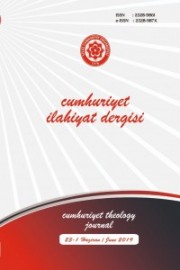Enverî-i Erzincânî ve Mevlûd-i Şerîf’i
Enverî Erzincânî and Mawlūd al-Sharīf
Author(s): Seydi KirazSubject(s): Islam studies, Turkish Literature, 17th Century, 18th Century
Published by: Cumhuriyet Üniversitesi İlahyat Fakültesi
Keywords: Turkish-Islamic Literature; Enverī Erzincānī; Mawlūd al-Sharīf; Wasila al-Nacāt; Mawlūd;
Summary/Abstract: Many mawlids (mawlid al-nabī) have been written as a reflection of the love for the prophet Muhammad. Süleymān Çelebi’s (d. 825/1422) Wasila al-nacāt, has been seen as the founding work in Turkish literature in this category. The effect of Wasila al-nacāt has continued for centuries, and inspired many other mawlids. One of them is Enverī Erzincānī’s work named Mawlūd al-sharīf (Sumbul al-gulzār al-kalām al-kadīm). In literature tradition, mawlids are written in masnawī in verse form, Mawlūd al-sharīf was written in style. ode. In this respect, the work can be seen as an exception between the other ones. Another remarkable aspect of the work is the similarity between the two stories in Nasibī al-mawlid which is estimated to be written in XV. or XVI. century. Until now, no academic work has been done about Mawlūd al-sharīf. The sources that provide information about Mawlūd al-sharīf report about, two copies, one in Çorum Hasanpasha Manuscript Library (Çorum Hasanpaşa Yazma Eserler Kütüphanesi) and the other in Kastamonu Manuscript Library (Kastamonu Yazma Eserler Kütüphanesi). Research showed that the copy in Kastamonu was in fact another copy of Wasila al-nacāt another copy of Mawlūd al-sharīf was also found in the Çorum Hasanpasha Manuscript Library (Çorum Hasanpaşa Yazma Eserler Kütüphanesi). The number of couplets of Mawlūd al-sharīf has increased to 202 with the finding of the second copy. About the author of the work that is approximatly written in the XVII. or XVIII. century no information could be found. This study, introduces the Mawlūd al-sharīf and its authors, compares it with Wasila al-nacāt and presents an critical analysis of the text.
Journal: Cumhuriyet İlahiyat Dergisi
- Issue Year: 23/2019
- Issue No: 1
- Page Range: 461-495
- Page Count: 35
- Language: Turkish

